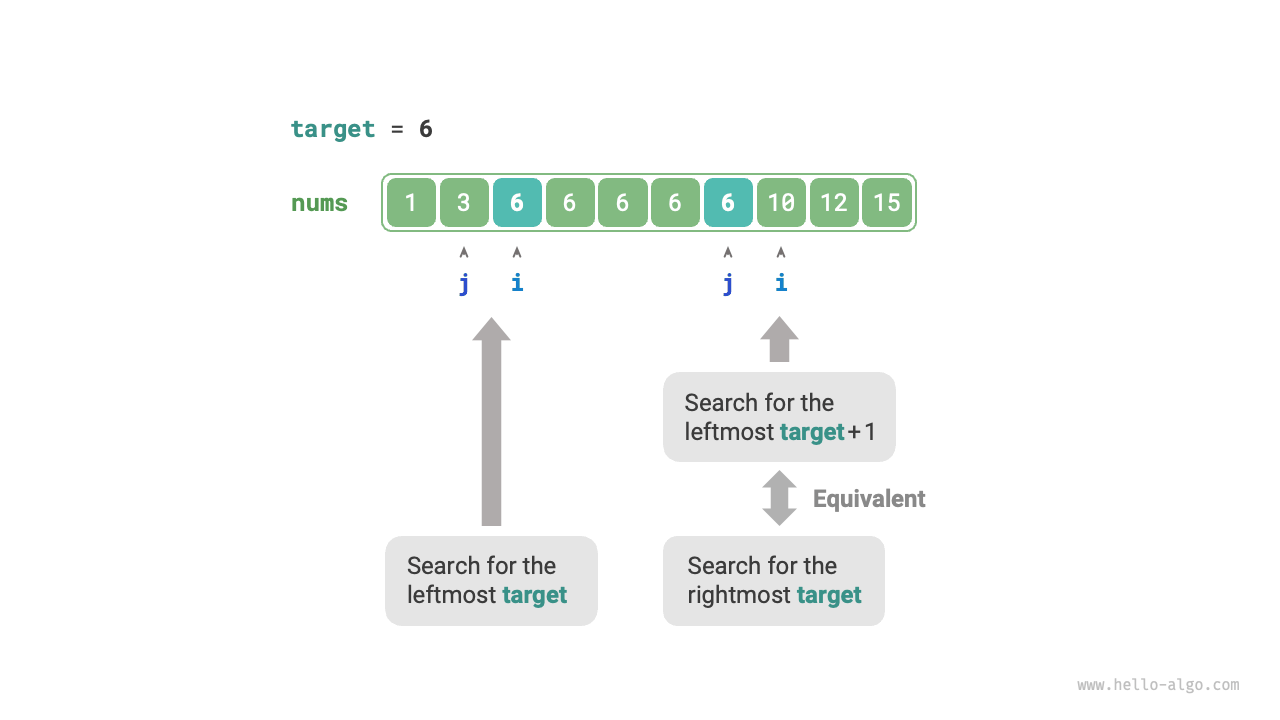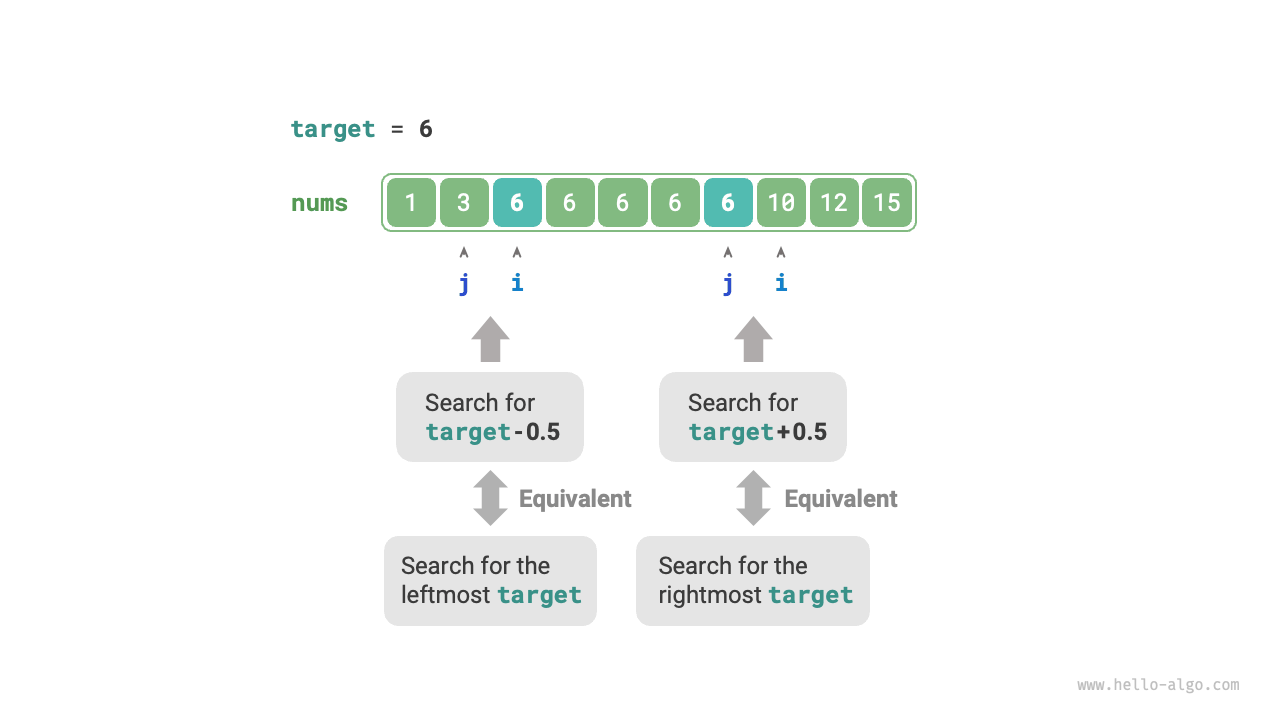10.3 Binary search boundaries¶
10.3.1 Find the left boundary¶
Question
Given a sorted array nums of length \(n\), which may contain duplicate elements, return the index of the leftmost element target. If the element is not present in the array, return \(-1\).
Recall the method of binary search for an insertion point, after the search is completed, \(i\) points to the leftmost target, thus searching for the insertion point is essentially searching for the index of the leftmost target.
Consider implementing the search for the left boundary using the function for finding an insertion point. Note that the array might not contain target, which could lead to the following two results:
- The index \(i\) of the insertion point is out of bounds.
- The element
nums[i]is not equal totarget.
In these cases, simply return \(-1\). The code is as follows:
def binary_search_left_edge(nums: list[int], target: int) -> int:
"""Binary search for the leftmost target"""
# Equivalent to finding the insertion point of target
i = binary_search_insertion(nums, target)
# Did not find target, thus return -1
if i == len(nums) or nums[i] != target:
return -1
# Found target, return index i
return i
/* Binary search for the leftmost target */
int binarySearchLeftEdge(vector<int> &nums, int target) {
// Equivalent to finding the insertion point of target
int i = binarySearchInsertion(nums, target);
// Did not find target, thus return -1
if (i == nums.size() || nums[i] != target) {
return -1;
}
// Found target, return index i
return i;
}
/* Binary search for the leftmost target */
int binarySearchLeftEdge(int[] nums, int target) {
// Equivalent to finding the insertion point of target
int i = binary_search_insertion.binarySearchInsertion(nums, target);
// Did not find target, thus return -1
if (i == nums.length || nums[i] != target) {
return -1;
}
// Found target, return index i
return i;
}
10.3.2 Find the right boundary¶
So how do we find the rightmost target? The most straightforward way is to modify the code, replacing the pointer contraction operation in the case of nums[m] == target. The code is omitted here, but interested readers can implement it on their own.
Below we introduce two more cunning methods.
1. Reusing the search for the left boundary¶
In fact, we can use the function for finding the leftmost element to find the rightmost element, specifically by transforming the search for the rightmost target into a search for the leftmost target + 1.
As shown in Figure 10-7, after the search is completed, the pointer \(i\) points to the leftmost target + 1 (if it exists), while \(j\) points to the rightmost target, thus returning \(j\) is sufficient.
Figure 10-7 Transforming the search for the right boundary into the search for the left boundary
Please note, the insertion point returned is \(i\), therefore, it should be subtracted by \(1\) to obtain \(j\):
def binary_search_right_edge(nums: list[int], target: int) -> int:
"""Binary search for the rightmost target"""
# Convert to finding the leftmost target + 1
i = binary_search_insertion(nums, target + 1)
# j points to the rightmost target, i points to the first element greater than target
j = i - 1
# Did not find target, thus return -1
if j == -1 or nums[j] != target:
return -1
# Found target, return index j
return j
/* Binary search for the rightmost target */
int binarySearchRightEdge(vector<int> &nums, int target) {
// Convert to finding the leftmost target + 1
int i = binarySearchInsertion(nums, target + 1);
// j points to the rightmost target, i points to the first element greater than target
int j = i - 1;
// Did not find target, thus return -1
if (j == -1 || nums[j] != target) {
return -1;
}
// Found target, return index j
return j;
}
/* Binary search for the rightmost target */
int binarySearchRightEdge(int[] nums, int target) {
// Convert to finding the leftmost target + 1
int i = binary_search_insertion.binarySearchInsertion(nums, target + 1);
// j points to the rightmost target, i points to the first element greater than target
int j = i - 1;
// Did not find target, thus return -1
if (j == -1 || nums[j] != target) {
return -1;
}
// Found target, return index j
return j;
}
2. Transforming into an element search¶
We know that when the array does not contain target, \(i\) and \(j\) will eventually point to the first element greater and smaller than target respectively.
Thus, as shown in Figure 10-8, we can construct an element that does not exist in the array, to search for the left and right boundaries.
- To find the leftmost
target: it can be transformed into searching fortarget - 0.5, and return the pointer \(i\). - To find the rightmost
target: it can be transformed into searching fortarget + 0.5, and return the pointer \(j\).
Figure 10-8 Transforming the search for boundaries into the search for an element
The code is omitted here, but two points are worth noting.
- The given array does not contain decimals, meaning we do not need to worry about how to handle equal situations.
- Since this method introduces decimals, the variable
targetin the function needs to be changed to a floating point type (no change needed in Python).

